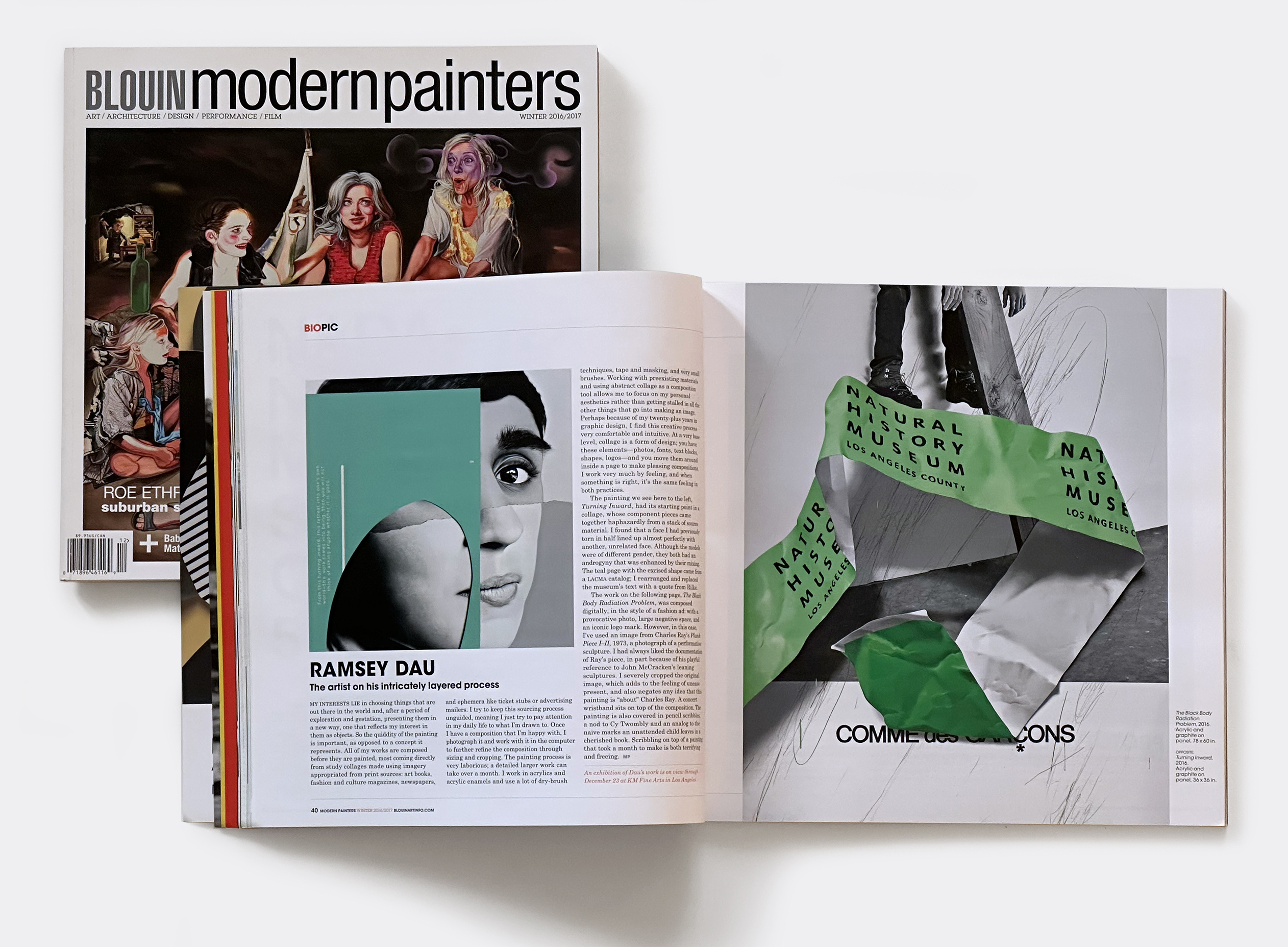RAMSEY DAU
Blouin Modern Painters (Winter 2016/2017)
 My interests lie in choosing things that are out there in the world and, after a period of exploration and gestation, presenting them in a new way, one that reflects my interest in them as objects. So the quiddity of the painting is important, as opposed to a concept it represents. All of my works are composed before they are painted, most coming directly from study collages made using imagery appropriated from print sources: art books, fashion and culture magazines, newspapers, and ephemera like ticket stubs or advertising mailers. I try to keep this sourcing process unguided, meaning I just try to pay attention in my daily life to what I'm drawn to. Once I have a composition that I'm happy with,I photograph it and work with it in the computer to further refine the composition through sizing and cropping. The painting process is very laborious; a detailed larger work can take over a month. I work in acrylics and acrylic enamels and use a lot of dry-brush techniques, tape and masking, and very small brushes. Working with pre-existing materials and using abstract collage as a composition tool allows me to focus on my personal aesthetics rather than getting stalled in all the other things that go into making an image. Perhaps because of my twenty-plus years in graphic design, I find this creative process very comfortable and intuitive. At a very base level, collage is a form of design; you have these elements - photos, fonts, text blocks, shapes, logos - and you move them around inside a page to make pleasing compositions. I work very much by feeling, and when something is right, it's the same feeling in both practices.
My interests lie in choosing things that are out there in the world and, after a period of exploration and gestation, presenting them in a new way, one that reflects my interest in them as objects. So the quiddity of the painting is important, as opposed to a concept it represents. All of my works are composed before they are painted, most coming directly from study collages made using imagery appropriated from print sources: art books, fashion and culture magazines, newspapers, and ephemera like ticket stubs or advertising mailers. I try to keep this sourcing process unguided, meaning I just try to pay attention in my daily life to what I'm drawn to. Once I have a composition that I'm happy with,I photograph it and work with it in the computer to further refine the composition through sizing and cropping. The painting process is very laborious; a detailed larger work can take over a month. I work in acrylics and acrylic enamels and use a lot of dry-brush techniques, tape and masking, and very small brushes. Working with pre-existing materials and using abstract collage as a composition tool allows me to focus on my personal aesthetics rather than getting stalled in all the other things that go into making an image. Perhaps because of my twenty-plus years in graphic design, I find this creative process very comfortable and intuitive. At a very base level, collage is a form of design; you have these elements - photos, fonts, text blocks, shapes, logos - and you move them around inside a page to make pleasing compositions. I work very much by feeling, and when something is right, it's the same feeling in both practices.The painting we see here to the left, Turning Inward, had its starting point in a collage, whose component pieces came together haphazardly from a stack of source material. I found that a face I had previously torn in half lined up almost perfectly with another, unrelated face. Although the models were of different gender, they both had an androgyny that was enhanced by their mixing. The teal page with the excised shape came froma LACMA catalog; I rearranged and replaced the museum's text with a quote from Rilke.
The work on the following page, The BlackBody Radiation Problem, was composed digitally, in the style of a fashion ad: with aprovocative photo, large negative space, and an iconic logo mark. However, in this case, I’ve used an image from Charles Ray's PlankPiece I-II, 1973, a photograph of a performative sculpture. I had always liked the documentation of Ray's piece, in part because of his playful reference to John McCracken's leaning sculptures. I severely cropped the original image, which adds to the feeling of unease present, and also negates any idea that this painting is "about' Charles Ray. A concert wristband sits on top of the composition. The painting is also covered in pencil scribbles, a nod to Cy Twombly and an analog to the naive marks an unattended child leaves in a cherished book. Scribbling on top of a painting that took a month to make is both terrifying and freeing.